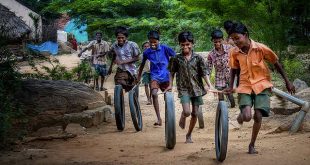Question: Name large scale industries. Answer: The large scale industries are as under: Textile industries Iron and Steel industry Sugar industry Cement industry Aircraft industry Question: Why is iron and steel industry called basic industry? Answer: The iron and steel industry is called a basic industry because it provides iron and …
Read More »Search Results for: CBSE
NCERT 8th Class (CBSE) Science: Sound
Question: How is sound produced? Answer: Sound is produced by rapid to-and-fro movements called vibrations. Question: Distinguish between infrasonic and ultrasonic. Answer: Difference is as follows: Question: What do you mean by time period of a vibrating object? Answer: The time taken for one complete vibration or oscillation is called its time period. Question:What is …
Read More »NCERT 8th Class (CBSE) Social Science: Major Crops And Agricultural – Quiz
NCERT 8th Class (CBSE) Social Science: Major Crops And Agricultural – Quiz 5 Multiple Choice Questions related to NCERT 8th Class (CBSE) Social Science: Major Crops And Agricultural – Quiz: Rice is grown in hot and humid tropical and subtropical regions. Wheat is cultivated in the mid-latitudes and in the …
Read More »NCERT 8th Class (CBSE) Social Science: Major Crops And Agricultural
Question: Write a short note explaining the different cropping seasons. Answer: There are three major cropping seasons, i.e. Rabi, Kharif and Zaid. Rabi: Crops are sown in winters between October to December and harvested between February to April. Major crops of this season are: wheat, barley, peas, gram, and oil seeds. …
Read More »NCERT 8th Class (CBSE) Social Science: Natural Resources – Land, Soil and Water – Quiz
NCERT 8th Class (CBSE) Social Science: Natural Resources – Land, Soil and Water – Quiz 21 Multiple Choice Questions related to NCERT 8th Class (CBSE) Social Science: Natural Resources-Land, Soil and Water – Quiz: The earth’s surface has about three-fourths water, so it is called “water planet”. Fresh water is …
Read More »NCERT 8th Class (CBSE) Social Science: Natural Resources – Land, Soil and Water
Question: What are the possible reasons behind the uneven distribution of population around the world? Answer: The reasons behind uneven population distribution are mainly the varied conditions of land and climate. Question: Give three common forms of land use. Answer: Three common land use forms are: As cropland Pasture Forests. …
Read More »NCERT 8th Class (CBSE) Social Science: Natural Resources – Natural Vegetation – Quiz
NCERT 8th Class (CBSE) Social Science: Natural Resources – Natural Vegetation – Quiz 10 Multiple Choice Questions related to NCERT 8th Class (CBSE) Social Science: Natural Resources-Natural Vegetation – Quiz: The equatorial forests have evergreen trees, while the monsoon forest have deciduous trees. Elephants, crocodiles, zebras, leopards, camels and ostriches …
Read More »NCERT 8th Class (CBSE) Social Science: Manufacturing Industries
Question: Define industry. Answer: Industry refers to an economic activity that is concerned with production of goods, extraction of minerals or provision of services. Question: Name three common methods of classifying industries. Answer: Industries are classified according to raw material used, size and ownership. Question: Expand the abbreviation AMUL. Where …
Read More »NCERT 8th Class (CBSE) Social Science: Agriculture – Quiz
NCERT 8th Class (CBSE) Social Science: Agriculture – Quiz 27 Multiple Choice Questions related to NCERT 8th Class (CBSE) Social Science: Agriculture – Quiz: The three types of economic activities are involved in the transformation from a plant to a finished product. Agricultural activities are concentrated in those areas of …
Read More »NCERT 8th Class (CBSE) Social Science: Agriculture
Question: What is the basic function of the three basic types of economic activities? Answer. The three types of economic activities are involved in the transformation from a plant to a finished product. Question: What are tertiary activities? Answer: Tertiary activities are those which provide support to primary and secondary …
Read More » Class Notes NCERT Solutions for CBSE Students
Class Notes NCERT Solutions for CBSE Students




